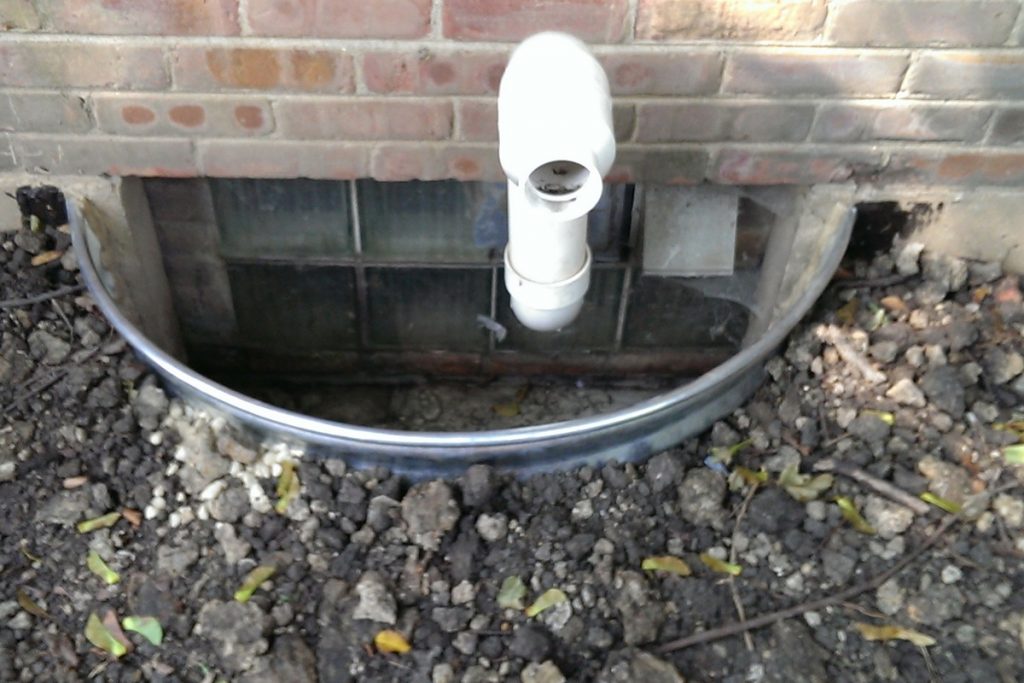During heavy rains window wells have a tendency to fill up with water that ultimately ends up in the basement. In this article we explain all that you need to know about window well drainage problems and how to solve them.
On this page:
How window well drainage problems cause window leaks
Images of window well drainage problems
Window well drainage facts
Clear evidence of inadequate window well drainage
How to Improve window well drainage
Recommended window well maintenance
How window well drainage problems cause basement leaks
When a window well is not installed, improperly sized, or if the window well drain is clogged, window well drainage problems cause water leaks into the basement. If the gravel in your window well doesn’t drain well, water can pool in the window well as if you had an aquarium outside. This accumulated water, when high enough, can pour straight into your basement between the window frame and the top of wall, or leak through the window itself!
Inadequate window well drainage can cause a substantial amount of water to pour into your basement very rapidly, thus creating a need for improved window well drainage and/or window well replacement.
Water pouring through a window into your basement does not mean that you need to replace the window. Your basement windows are not designed to be underwater; the problem is with the window well – not the window.
Signs of window well drainage problems
Window well drainage facts
Today’s construction practices mandate the installation of window wells when basement windows are at or below grade. Generally, new window well installations include drains to to the weeping tile in order to prevent water accumulation in the window wells. A window well drain channels water accumulated in a window well to the weeping tile system installed along the footing which then drains to a sump pump installed in the basement, or to the storm sewer under the street.
In this next picture, in front of the person’s foot, you can see an old clay drain pipe that no longer provides adequate drainage because the drain is clogged with silt.
Clear evidence of inadequate window well drainage
When the foundation wall is visible from inside you will typically notice soil staining beneath the window frame, proving that water entered the basement through the window or from beneath the window frame. This situation is attributable to poor or inadequate window well drainage. Note that, in this case, window well drainage was not the only problem that was found, there was also a crack at the right hand window corner that was leaking.
Caution: The symptoms of inadequate window well drainage are often attributed to the window itself, and many homeowners replace their basement windows unnecessarily. Leaking windows are rarely to blame for major basement leaks; in fact, the only time a window leaks is when the caulking around the window frame is missing or has deteriorated to the point that water can penetrate the building envelope between the window frame and the foundation.
In the picture immediately above this text it is clear that what appeared to be a single leak actually involved two separate leaks – a poorly draining window well in addition to a foundation crack at the right hand corner of the window. The image provides an excellent example of the importance of inspecting bare foundation walls, from the inside, to confirm all the cause(s) of a wet basement.
How to Improve Window Well Drainage
To correct window well drainage problems, a new, properly draining, window well drain is usually installed. These drains can be installed the traditional way (by excavating down to the footing and connecting to the weeping tile) or by using our leading edge method of augering a new drain. Both methods involve the installation of a drain pipe to carry water in the window well to the weeping tile system that drains this water away.
If you already have a window well drain it is probably clogged with sediment. Removing the sediment to a depth of 1′ should get the drain working again. Watch for eavestroughs that dump water into a window well. If that happens, fix the eavestrough or consider installing a custom made window well cover.
The window well drain installation process – Augering method
Step 1: Auger a hole down to the gravel layer surrounding the weeping tile
Step 2: Install a drain pipe to carry the water into the gravel layer
A proper window well drain installation looks like this:
Recommended Window Well Maintenance
A window well drain is very similar to the drain in your kitchen sink, if it is plugged with food, water will not drain away. For good window well drainage, water must be able to penetrate the gravel layer and make its way to the weeping tile via the drain pipe. If leaves and other debris accumulate in the window well, thus preventing rain water from draining through the gravel layer, the water will pool in the window well and the window well drain will be of little value. If the water is allowed to pool it will eventually rise until it pours into your basement right through the windows! Keeping the window well gravel layer free of debris is an absolute must. A window well cover is an effective way of keeping your window well gravel layer clear of debris at all times.
Considering the purchase of a window well cover to solve your window well drainage problems? Read our blog post: Window Well Covers – Facts and Fiction
